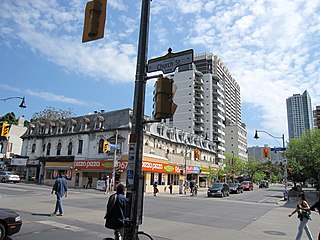
Church and Wellesley is an LGBT-oriented enclave in Toronto, Ontario, Canada. It is roughly bounded by Gerrard Street to the south, Yonge Street to the west, Charles Street to the north, and Jarvis Street to the east, with the core commercial strip located along Church Street from Wellesley south to Alexander. Though some gay and lesbian oriented establishments can be found outside this area, the general boundaries of this village have been defined by the Gay Toronto Tourism Guild.
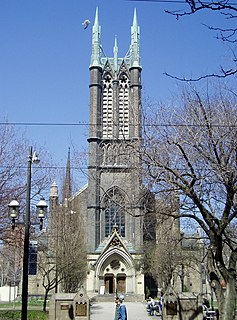
Metropolitan United Church is a historic Neo-Gothic style church in downtown Toronto, Ontario, Canada. It is one of the largest and most prominent churches of the United Church of Canada. It is located at 56 Queen Street East, between Bond and Church streets, in Toronto's Garden District.
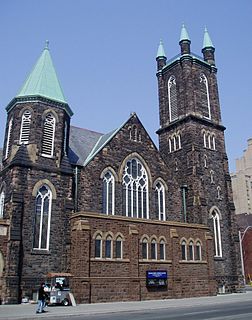
Bloor Street United Church is a United Church of Canada church in Toronto, Ontario, Canada. It is located downtown near the intersection with Huron Street. It is just north of the University of Toronto, and between the Spadina and St. George subway stations.

The Randolph Theatre is a 500 seat theatre in Toronto, Ontario, that is housed in a former church. The Gothic revival building is located at 736 Bathurst Street at the intersection with Lennox Street. The theatre is in the former church sanctuary, while the 100-seat Annex Theatre is in an adjoining building at 730 Bathurst Street.
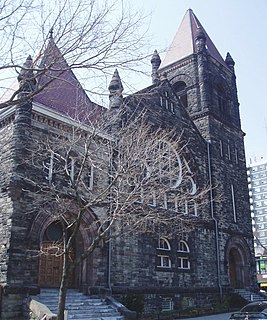
Trinity-St. Paul's United Church and Centre for Faith, Justice and the Arts is a church belonging to the United Church of Canada in Toronto, Ontario, Canada. It is located at 427 Bloor Street West, just west of Spadina Avenue in the city's downtown core. The church is formed of a mix of three different former congregations and houses a fourth independent congregation within its building.
St. Paul's Presbyterian Church is a Presbyterian Church in Canada congregation located in the community of Leaskdale, Ontario, part of Uxbridge Township, Ontario Canada. It was started in March 1862 with thirteen Charter members, as the Scott Township mission of the Canada Presbyterian Church.

The Garden District is a neighbourhood in downtown Toronto, Ontario, Canada. The name was selected by the Toronto East Downtown Residents Association (TEDRA) in recognition of Allan Gardens, an indoor botanical garden located nearby at the intersection of Carlton and Jarvis Streets. The Garden District was officially designated by the Mayor and Toronto City Council in 2001, while TEDRA has since been renamed the Garden District Residents Association. Part of the neighbourhood is within official City of Toronto neighbourhood of Moss Park.

The First Unitarian Congregation of Toronto is a Unitarian Universalist (UU) congregation in Toronto, Ontario, Canada. It is affiliated with the Canadian Unitarian Council. It is the largest of six UU congregations and fellowships in the Greater Toronto Area.

First Evangelical Lutheran Church is a congregation of the Eastern Synod of the Evangelical Lutheran Church in Canada, located at 116 Bond Street in Toronto, Ontario, Canada that serves the communities of Toronto, and the Greater Toronto Area. The church offers services in both the English and German languages. The church was founded in 1851.
St. Paul United Methodist Church is located in the historic Grant Park neighborhood of Atlanta, Georgia. For a time in the early 1900s, St. Paul had the largest Methodist congregation in the Southeastern United States. The church organ was acquired at the Cotton States Exhibition in 1887. St. Paul's stained glass windows, which date back to 1907, are being refurbished. St. Paul is a main stop on tours of the Grant Park neighborhood given by the Atlanta Preservation Center. St. Paul is also home to the Grant Park Cooperative Preschool. St. Paul, the Grant Park Cooperative Preschool and the Grant Park Parent Network host the annual Grant Park Candlelight Tour of Homes, which also includes an artist marketplace and a Winter Wonderland for children. The Candlelight Tour of Homes begins at St. Paul.

Pearl Memorial United Methodist Church was a member of the Nebraska Conference of the United Methodist Church that was operated from the 1890s into the 2000s. The former congregation's church is located at 2319 Ogden Street in the Miller Park neighborhood of north Omaha, Nebraska. The church primarily served the Miller Park community.

West Market Street United Methodist Church is one of the oldest churches in Greensboro North Carolina, over 175 years old; West Market is located in downtown Greensboro across from the courthouse. West Market is a relatively large church with approximately 2000 members, though not all are active. The current sanctuary was completed in 1893, the third sanctuary built by the congregation. Today the church has grown, with a larger wing adjacent to the sanctuary, and other properties held at other locations. The current Pastor is Dan Martin, with associate pastors Jill Aventosa-Brown, Rhiannon Kelly, Ginger Shields, Erin Althaus, and Bill Ellison.
University United Methodist Church, Austin, Texas, is a United Methodist Church belonging to the Rio Texas Conference of the United Methodist Church. Located at the corner of 24th Street and Guadalupe Street, UUMC has been a fixture near the University of Texas at Austin campus for more than 120 years.
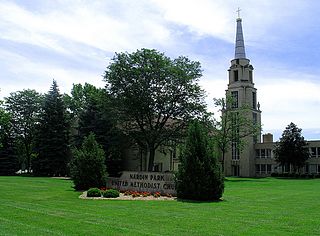
Nardin Park United Methodist Church is a Methodist church situated in Farmington Hills, Michigan. Nardin Park was first formed in 1927 by the union of two large churches in northwest Detroit - the Grand River Avenue Church, established in 1891, and the Ninde Church, organized in 1886. The name 'Nardin Park' was taken from the park and the subdivision where the church was located Nardin Park United Methodist Church was officially listed in Michigan's register of historic sites on September 21, 1990.
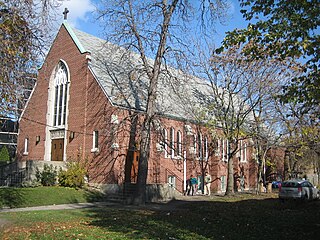
Trinity Evangelical Lutheran Church is a Lutheran Church–Canada congregation in Toronto, Ontario, Canada. The church was completed in 1952, it was designed by W.E. Noffke, who was a prolific architect in Canada, he designed many Lutheran church buildings across the province. It is located at the corner of Sherbourne and Bloor Street in the northeast of the city's downtown. It was founded in 1931 as a Lutheran Church–Missouri Synod congregation, the second in the city after St. John's Lutheran Church. It originally catered to German immigrants in the city, and the services were all in German until the Second World War when it was decided to switch to English. After meeting in a number of temporary sites around the city, the church purchased land at Bloor and Sherbourne in 1943 and completed the present building in 1952. Services in German resumed, and as new immigrant groups to Canada arrived services began in other languages including Latvian and Estonian in 1952 and separate Korean services in 1988.
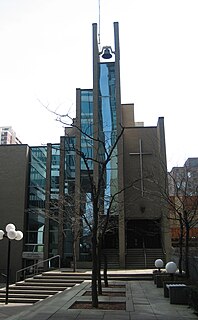
St. Andrew's United Church is an historic congregation of the United Church of Canada in Toronto, Ontario, Canada. Located in the city's downtown core near the intersection of Yonge and Bloor it is a combination of five other downtown Toronto congregations. The church originated from St. Andrew's Church, founded in 1830 as the first Church of Scotland congregation in what was then the town of York. The original St. Andrew's was located at the corner of Adelaide and Church Streets. By the 1870s it had become clear that a new church was needed. The downtown core had moved westward, and most of the congregation wanted to shift in that direction as well, but a minority staunchly opposed the idea. With the congregation thus split, the majority moved to a new structure at King and Simcoe in 1876 that still exists today as St. Andrew's Church.

Asbury & West United Church is a United Church of Canada church in the Bathurst and Lawrence area of Toronto, Ontario, Canada. The congregation has one of the longest continual histories of any in Toronto. It traces its history back to 1812 and meetings of small groups of Methodist settlers in what was an area being newly settled by Europeans. The first services were held in the farmhouse of Henry Mulholland, a veteran of the War of 1812 and the Battle of Lundy's Lane. He first came to Canada from Ireland in 1806, settling in the area that would later be named Henry Farm after him. He later moved further west to what is now the Bathurst and Lawrence area.

Built in 1912, the First Presbyterian Church of Redmond is the oldest standing church structure in the city of Redmond, Oregon, United States. It is also the second-oldest religious building in Deschutes County. The church was built in the Gothic Revival style with Queen Anne architectural detailing. It was the home of Protestant congregations from 1912 until 1979. Today, the building is privately owned and used as a special events venue. The First Presbyterian Church of Redmond was listed on the National Register of Historic Places in 2001.

The Bethel A.M.E. Church, known in its early years as Indianapolis Station or the Vermont Street Church, is a historic African Methodist Episcopal Church in Indianapolis, Indiana. Organized in 1836, it is the city's oldest African-American congregation. The three-story church on West Vermont Street dates to 1869 and was added to the National Register in 1991. The surrounding neighborhood, once the heart of downtown Indianapolis's African American community, significantly changed with post-World War II urban development that included new hotels, apartments, office space, museums, and the Indiana University–Purdue University at Indianapolis campus. In 2016 the congregation sold their deteriorating church, which will be used in a future commercial development. The congregation built a new worship center at 6417 Zionsville Road in Pike Township, Marion County, Indiana.

Roberts Park Methodist Episcopal Church, whose present-day name is Roberts Park United Methodist Church, was dedicated on August 27, 1876, making it the oldest church remaining in downtown Indianapolis. Diedrich A. Bohlen, a German-born architect who immigrated to Indianapolis in the 1850s, designed this early example of Romanesque Revival architecture. The church is considered one of Bohlen's major works. Constructed of Indiana limestone at Delaware and Vermont Streets, it has a rectangular plan and includes a bell tower on the southwest corner. The church is known for its interior woodwork, especially a pair of black-walnut staircases leading to galleries (balconies) surrounding the interior of three sides of its large sanctuary. The church was added to the National Register of Historic Places on August 19, 1982. It is home to one of several Homeless Jesus statues around the world, this one located behind the church on Alabama Street.




















